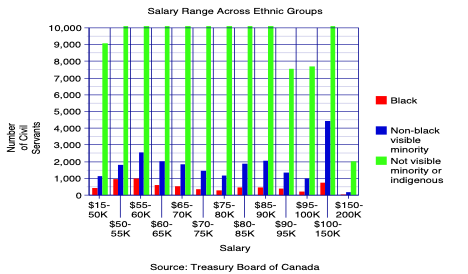In diversity there is beauty and there is strength. – MAYA ANGELOU
Prime Minister Pierre Elliot Trudeau officially ushered in diversity, equity, and inclusion in the Multiculturalism Act 1971. The Government of Canada raised public awareness of systemic barriers that targeted underrepresented and disadvantaged groups in the workforce. Today, this includes women in management, Black Canadians, Indigenous peoples, individuals with disabilities, and those identifying as LGBTQ2+.
Every person is entitled to equal treatment without discrimination in the workplace under the Canadian Charter of Rights and Freedoms. Yet, minority communities face workplace obstacles. Racism, career disparities, and pay gaps like those revealed in the chart below are far too common in a “Just Society”. The federal government has responded by designing and introducing new programs, community services, and more funding for disadvantaged groups. An overarching goal is to enhance wider social and economic development by modelling initiatives and results in the public service.

Framing the issue
Progress across the Public Service of Canada appears promising on the surface. However, 2019 Treasury Board of Canada statistics reveal that people of colour, especially Black Canadians, occupy few positions of power at executive and senior management levels. Less than four percent of executive positions in the federal public service are held by Indigenous people, and less than ten percent are held by other visible minorities. February 2020 marked the first time that a Black person achieved the rank of Associate Deputy Minister when Caroline Xavier was appointed to the Ministry of Immigration, Refugees, and Citizenship.
There are also noticeable disparities within the private sector. A Financial Post study reviewed corporate diversity among Fortune 500 companies in Canada. Out of 23 boards and 255 director positions, only 14 directors (or 5.5 per cent) identified as members of a visible minority.
In December 2020, an unprecedented class-action lawsuit brought allegations of racial injustice and inequity against the Government of Canada. Twelve Black public servants are seeking redress of federal employment discrepancies. The claimants contest categorizing Black employees under the Employment Equity Act as visible minorities, along with all non-white and non-Indigenous people. They claim that this represents systemic racism that discriminates against promotional opportunities within the public service. It also fails to acknowledge and empower those who may be struggling to get ahead on merit.
Sustainable strategies
The way forward harnesses three strategies:
- Enforce accountability via a top-down, third-party audit. An independent commission should review systemic barriers and oversee administration of the Employment Equity Act to ensure that diversity and inclusion policies are being implemented.
- Amend the Employment Equity Act. Visible minorities should be segmented into specific visible minority sub-groups, including Black Canadians.
- Promote inclusion through leadership rather than quotas. Leaders and managers should advance end-to-end employee experiences by developing policies that promote day-to-day inclusion and by designing department-specific performance measures that assess the impact.
Countering systemic barriers faced by marginalized communities empowers inclusivity and economic growth. A multicultural society and an inclusive public sector that capitalize on diversity as strength is the linchpin of Canadian nation building. The Government of Canada is poised to inspire the next generation of public servants with a brave-new vision of diversity, equity, and inclusion.

